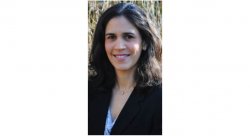Collaboration Shines at the New SCM
Posted in: School of Communication and Media News

On MSU’s campus, ubiquitous signs proclaim the message that “It’s all here.” Well, that proved to be very true for Professor Tara George. This semester, George was able to utilize the new headquarters, another faculty member, several students, the facilities and equipment, for the School of Communication and Media to produce a highly riveting story about a man wrongfully convicted of murder. That story was seen recently on NJTV.
A journalist with The New York Daily News for six years, and an Associate Professor of Journalism at Purchase College for 12 years, Professor George is now in her first semester teaching Journalism at MSU. She explains how the story developed. “About a year ago, I was working on a story for New Jersey Monthly Magazine and became aware of this particular story. I’ve spent this semester doing research on this case and the interesting issues that spin out of it.”
In 1996, Gerard Richardson was tried and convicted of murdering 19 year old Monica Reyes. He has maintained his innocence all along and has been asking for a DNA test to prove it. In 2012, his request was granted. After nearly 20 years behind bars, the test showed that Richardson was not guilty of the crime in question.
One of the many factors that make this case compelling is that it showcases the advances that have been made in DNA forensic science over the last 20 years. Back in the 1990s, scientists would have needed a sample of DNA the size of a quarter to perform a test. In Richardson’s case, they didn’t have it. All they had was a very small drop of DNA taken from a bite mark on the victim’s body.
Today, a small DNA sample the size of a grain of sugar is enough to conclusively prove guilt or innocence. “It was a one shot deal,” says George, “because processing the sample meant that it would be used up and gone.” Fortunately, one shot was all they needed to exonerate Richardson. It is estimated that Richardson is the 11th person in the state of New Jersey to be exonerated due to advances in DNA testing.
After doing extensive research on the case, George enlisted the help of broadcast professor Steve McCarthy and the students in his News Production Lab class. “We shot the story in two locations,” said George. “One was in Elizabeth where we interviewed Richardson at his daughter’s house. The other was in Manhattan, at The Innocence Project – a group that specializes in DNA exonerations – where Richardson’s attorney works.”
At times the collaborative process got very creative. When it proved difficult to locate the family of the victim due to the passage of so much time, Professor McCarthy gave his students a challenge: any student able to locate the family of the victim would receive an A in the class. The students took the challenge seriously. They were able to located Reyes’ sister, Lucy, through Facebook. They utilized a special feature that allows users to pay extra for the ability to message someone that is not already a “Friend.” Reyes’ sister has been raising Reyes’ son who was two years old at the time of the murder. Understandably, the family has been dealing with extremely mixed emotions at this shocking turn of events.
Which leads to the obvious question, if Richardson did not commit this crime, who did? There is a good chance that the answer lies in an FBI database called CODIS. The database contains the DNA profiles of almost 11 million convicted felons. If they were to run the DNA profile that cleared Richardson’s name through the database, there is the chance of finding a match that could lead to the real murderer.
As if all of this isn’t enough, there is one final irony to this case. It seems that Richardson was exonerated just 10 days before New Jersey passed a law raising the settlement paid to those wrongfully convicted from $20,000 per year served to $50,000 per year. Richardson is currently suing the state in this matter.
Professor George emphasized the team work that went into this project. “I’m mostly a writer and I had to learn to tell a story on TV. That meant thinking more visually and acquiring a greater sense of brevity.” George feels that this effort really allowed the whole SCM to shine. “At one point we needed the Radio Lab and we had help from students in that department. No matter what I needed, help with it was all right here under one roof at Morehead Hall.”
NJTV News and Mary Alice Williams made the project possible by being willing to air it on the local news. “When it was done, we delivered it with a red bow to NJTV’s studio on campus and they aired it for us,” said George. The piece ran on NJTV News on Thanksgiving and can also be found on their website.
This fall is the first time the entire SCM has been housed together in the newly renovated Morehead Hall. George feels that this effort shows the potential of having all the various disciplines so easily within reach. She is looking forward to seeing more of this kind of school collaboration in the future.
